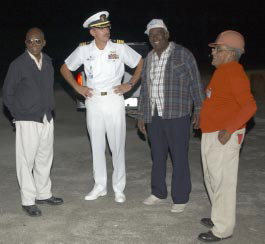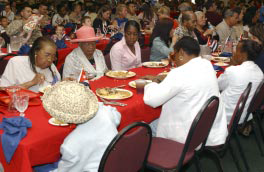Guantanamo Bay Naval Base/Cuban workers
When Fidel Castro took power in Cuba approximately 2000 Cuban citizens were employed by the United States at its Guantanamo Bay Naval Base.[1][2][3] The United States was prepared to offer asylum to the Cuban citizens it employed. Alternately, they would be allowed to continue to commute to work on the base. No new Cubans were hired since the Castro administration came to power. By 1985 the number of Cuban workers who had requested a
Contents
Special Category Residents
The Cuban workers who have been granted asylum are called Special Category Residents.[4] They weren't normally granted US citizenship, but some of them had children who became American citizens, like Cesar Aldama.[5][6] In 1969 approximately 2,000 Special Category Residents lived on the base.[4] In 2005 56 Special Category Residents lived on the base. By February, 2010, the number of Special Category Residents had shrunk to 39.[4]
Commuters

According Captain Christopher Hibbert the Navy employed 3,600 Cuban workers in 1961.[7] According to Carol Rosenberg, in the Miami Herald, 18 commuters continued to work on the base in 1999.[2] In 2005 three elderly Cuban men continued to commute to Guantanamo, Harry Henry, Luis LaRosa and Ricardo Simono.[4] By December 2012 only Henry and LaRosa remained, and on December 14, 2012, the two men retired -- although Henry said he thought he had several more years of work left in him.[8] The USA paid its Cuban workers $12 an hour, very good wages by Cuban standards.
Rosenberg reported that, when Henry and La Rosa retire at the end of December the northeast gates will only open for the monthly liason between the US Navy Captain commanding the base and a local Cuban officer of equivalent rank.[2]
[9] Although the relationship between Cuba's new communist government and the USA were very strained, the then current Cuban workers were allowed to keep commuting to the their jobs. Some of the Cuban workers requested political asylum, and were allowed to live on the base. As of 2012 several dozen former Cuban workers live as retirees on the base. Harry Henry, 82, and Luis La Rosa, 79, the last two remaining Cuban workers who commuted to their jobs, retired on December 14, 2012.
On December 31st, their last day on the job, Carol Rosenberg, of the Miami Herald described how the retirement of the men posed a problem for all the retired commuters.[10] The USA's trade embargo with Cuba complicated the usual ways the USA could pay the retired workers their pensions. Until the retirement of Henry and LaRosa retired commuters counted on the remaining commuters carrying their pensions to them. Rosenberg wrote that base officials had been foreseeing the day the last commuter retired, and, even so, had not yet figured out a new payment method that was both trustworthy and complied with the embargo. She quoted Jonathan M. Hansen, who wrote “Guantánamo: An American History,”, who predicted the retired commuters would never see another pension payment.
- “Every cute story that comes out of that place has another dark side to it. So it doesn’t surprise me, actually, that they’re not going to get these pensions.”
On January 3, 2013, Carol Rosenberg, of the Miami Herald, reported that Lieutenant Colonel Todd Breasseale, a Guantanamo spokesman, had announced that a procedure had been found to pay the retired Cuban commuters their pension.[11] Breasseale declined to say how the payments would be made. But he did supply details as to how many retirees remained on the roster -- 67; and that the average payment was $684 per month.
Cuban American Friendship Day
In 1969 the base Commander Rear Admiral J. B. Hildreth instituted an annual celebration -- Cuban American Friendship Day on the last Friday of January.[4][7]
See also
References
- ↑
{{URL|example.com|optional display text}} - ↑ a b c
{{URL|example.com|optional display text}} - ↑
{{URL|example.com|optional display text}} - ↑
{{URL|example.com|optional display text}} - ↑
{{URL|example.com|optional display text}} - ↑
{{URL|example.com|optional display text}} - ↑
{{URL|example.com|optional display text}} - ↑
{{URL|example.com|optional display text}} - ↑
{{URL|example.com|optional display text}}
